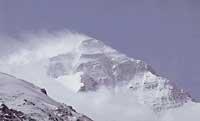The wind gusts of Everest, cause of many accidents
The sudden decrease in atmospheric pressure causes problems in Everest. Now, a Canadian meteorologist discovers that strong gusts of wind cause a sudden drop in pressure.

In May 1996, eight people died due to the Everest storms. The story of these perverse storms was collected in a book, Into Thin Air. The mountaineers were waiting for good weather before ascending to the top, but soon after, the wind gusts quickly lowered pressure and the oxygen concentration reached dangerous levels. These conditions reduce up to 6% the amount of oxygen and 14% the respiratory capacity of the mountaineers. The oxygen faults were confused and disoriented by the mountaineer. Probably that is why there were fatal accidents.
For the study of the influence of the wind, meteorologists installed a series of meters on the southern hill of Everest in 1998. It is the highest weather station in the world, about 8,000 meters away. Through this station, the connection between the wind gusts and the descent of the instant pressure was confirmed.
Mountaineers have always taken into account the wind speed to decide whether they should start climbing or not, but meteorologists consider that from now on they will also have to take into account the strong gusts of wind that affect the pressure. Do not forget that it is easy to predict these wind gusts.





